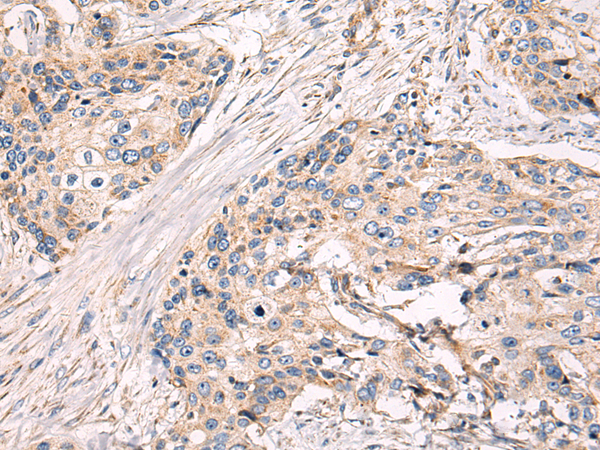
| WB | 咨询技术 | Human,Mouse,Rat |
| IF | 咨询技术 | Human,Mouse,Rat |
| IHC | 1/50-1/100 | Human,Mouse,Rat |
| ICC | 技术咨询 | Human,Mouse,Rat |
| FCM | 咨询技术 | Human,Mouse,Rat |
| Elisa | 1/5000-1/10000 | Human,Mouse,Rat |
| Aliases | WARBM3; RAB18LI1 |
| Host/Isotype | Rabbit IgG |
| Antibody Type | Primary antibody |
| Storage | Store at 4°C short term. Aliquot and store at -20°C long term. Avoid freeze/thaw cycles. |
| Species Reactivity | Human, Mouse, Rat |
| Immunogen | Fusion protein of human RAB18 |
| Formulation | Purified antibody in PBS with 0.05% sodium azide and 50% glycerol. |
+ +
以下是关于RAB18抗体的3篇文献示例(注:以下内容基于公开研究整理,若需引用请核实原文):
---
1. **文献名称**: *RAB18 modulates lipid droplet motility and lipophagy in hepatocytes*
**作者**: Liu Y, et al.
**摘要**: 本研究利用RAB18特异性抗体,揭示RAB18通过调控脂滴与内质网的相互作用影响肝细胞脂质代谢,并发现其在非酒精性脂肪肝中的潜在作用机制。
2. **文献名称**: *RAB18 loss causes secretory pathway defects and neurodegeneration in a Warburg Micro syndrome model*
**作者**: Bhuin T, et al.
**摘要**: 通过RAB18抗体进行免疫荧光和Western blot分析,发现RAB18缺失导致神经元分泌途径异常,为Warburg微综合征的分子机制提供了实验证据。
3. **文献名称**: *RAB18 interacts with TRAPPC complexes to regulate ER-Golgi trafficking*
**作者**: Gerondopoulos A, et al.
**摘要**: 该研究使用RAB18抗体进行共免疫沉淀实验,证实RAB18与TRAPPC蛋白复合物互作,参与内质网-高尔基体膜运输的调控。
---
提示:实际引用时建议通过PubMed或Web of Science检索最新文献,并注意选择抗体验证数据充分的文章(如标明货号、应用场景的论文)。
**Background of RAB18 Antibody**
The RAB18 antibody is a tool used to detect and study RAB18. a small GTPase belonging to the RAB family, which regulates intracellular vesicular trafficking and membrane dynamics. RAB18 plays a critical role in lipid droplet formation, endoplasmic reticulum (ER)-Golgi transport, and autophagy. Mutations in the *RAB18* gene are linked to Warburg micro syndrome, a rare autosomal recessive disorder characterized by neurodevelopmental defects, ocular abnormalities, and hypogenitalism. Additionally, RAB18 dysfunction is associated with neurodegenerative conditions and metabolic disorders, highlighting its importance in cellular homeostasis.
RAB18 antibodies are widely utilized in research to investigate protein localization, expression levels, and interactions via techniques like Western blotting, immunofluorescence, and immunoprecipitation. These antibodies help elucidate RAB18’s role in lipid metabolism, particularly its interaction with proteins like NSFL1C and its involvement in insulin-regulated pathways. Monoclonal and polyclonal RAB18 antibodies vary in specificity, with validation steps (e.g., knockout controls) ensuring reliability.
Current studies explore RAB18 as a potential biomarker or therapeutic target for metabolic syndromes and genetic disorders. Its dual role in secretory pathways and lipid storage underscores its multifaceted cellular functions, driving ongoing research to decode mechanistic links to disease pathologies.
×